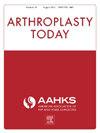Extended Oral Antibiotic Prophylaxis and Periprosthetic Joint Infection–Free Survivorship After Primary Total Hip Arthroplasty
IF 2.1
Q3 ORTHOPEDICS
引用次数: 0
Abstract
Background
Several studies have presented findings in favor of using extended oral antibiotic (EOA) prophylaxis to reduce periprosthetic joint infection (PJI) after primary total hip arthroplasty (THA) in patients at high risk for infection. To date, there is a paucity of evidence examining this topic from large retrospective databases. This study explored 90-day complication rates and 2-year PJI-free survivorship in a large cohort of patients receiving EOA prophylaxis after primary THA.
Methods
A large national database was used to identify patients undergoing primary THA from 2009 to 2022. Patients receiving 7-14 days of EOA were identified and propensity score–matched based on comorbidities to controls not receiving EOA and subsequently stratified into any-risk, high-risk, and standard-risk cohorts based on infection-related risk factors. Complication rates at 90 days were examined, and 2-year PJI-free survivorship was assessed employing Kaplan-Meier curves and Cox regression analysis further adjusting for comorbidity status.
Results
A total of 4153 patients receiving EOA prophylaxis after THA were identified. Of those patients, 2154 (52%) were considered high risk for PJI, while 1999 (48%) were considered standard risk. Significant reduction in hazards of PJI with administration of EOA was not seen at 90 days (any-risk: hazard risk [HR]: 0.75, 95% confidence interval [CI]: 0.42-1.35, P = .3; high-risk: HR: 0.85, 95% CI: 0.39-1.85, P = .7; standard-risk: HR: 1.29, 95% CI: 0.44-3.77, P = .6), 1 year (any-risk: HR: 0.99, 95% CI: 0.68-1.44, P > .9; high-risk: HR: 1.24, 95% CI: 0.77-1.99, P = .4; standard-risk: HR: 1.56, 95% CI: 0.73-3.33, P = .3), or 2 years (any-risk: HR: 1.02, 95% CI: 0.73-1.42, P > .9; high-risk: 1.25, 95% CI: 0.82-1.91, P = .3; standard-risk: HR: 1.10, 95% CI: 0.61-2.00, P = .8).
Conclusions
No significant increase in PJI-free survivorship at 90 days, 1 year, or 2 years was seen with EOA prophylaxis following primary THA. Reported PJI rates were low across all cohorts, irrespective of baseline risk. Further evidence is needed to adjudicate the efficacy of EOA prophylaxis after THA in addition to possible risks and appropriate indications for use.
原发性全髋关节置换术后延长口服抗生素预防和假体周围关节无感染存活
背景:一些研究表明,对于感染风险较高的患者,在初次全髋关节置换术(THA)后使用延长口服抗生素(EOA)预防来减少假体周围关节感染(PJI)。迄今为止,从大型回顾性数据库中检查这一主题的证据不足。本研究探讨了原发性THA后接受EOA预防的大队列患者的90天并发症发生率和2年无pji生存率。方法采用一个大型国家数据库,对2009年至2022年进行原发性THA手术的患者进行识别。确定接受7-14天EOA治疗的患者,并根据合并症与未接受EOA治疗的对照组进行倾向评分匹配,随后根据感染相关危险因素分为任意风险、高风险和标准风险队列。检查90天的并发症发生率,并采用Kaplan-Meier曲线和Cox回归分析评估2年无pji生存率,进一步调整合并症状态。结果共发现4153例THA术后接受EOA预防的患者。在这些患者中,2154例(52%)被认为是PJI的高风险,而1999例(48%)被认为是标准风险。在第90天,服用EOA后PJI的危险未见显著降低(任何风险:危险风险[HR]: 0.75, 95%可信区间[CI]: 0.42-1.35, P = .3;高危:HR: 0.85, 95% CI: 0.39-1.85, P = 0.7;标准风险:HR: 1.29, 95% CI: 0.44-3.77, P = 0.6), 1年(任何风险:HR: 0.99, 95% CI: 0.68-1.44, P >;。9;高危:HR: 1.24, 95% CI: 0.77 ~ 1.99, P = 0.4;标准风险:HR: 1.56, 95% CI: 0.73-3.33, P = .3)或2年(任何风险:HR: 1.02, 95% CI: 0.73-1.42, P >;。9;高危:1.25,95% CI: 0.82-1.91, P = 0.3;标准风险:HR: 1.10, 95% CI: 0.61-2.00, P = .8)。结论:原发性THA后EOA预防在90天、1年或2年无pji生存期未见显著增加。报告的PJI发生率在所有队列中都很低,与基线风险无关。除了可能的风险和适当的使用适应症外,还需要进一步的证据来判断THA后EOA预防的有效性。
本文章由计算机程序翻译,如有差异,请以英文原文为准。
求助全文
约1分钟内获得全文
求助全文
来源期刊

Arthroplasty Today
Medicine-Surgery
CiteScore
2.90
自引率
0.00%
发文量
258
审稿时长
40 weeks
期刊介绍:
Arthroplasty Today is a companion journal to the Journal of Arthroplasty. The journal Arthroplasty Today brings together the clinical and scientific foundations for joint replacement of the hip and knee in an open-access, online format. Arthroplasty Today solicits manuscripts of the highest quality from all areas of scientific endeavor that relate to joint replacement or the treatment of its complications, including those dealing with patient outcomes, economic and policy issues, prosthetic design, biomechanics, biomaterials, and biologic response to arthroplasty. The journal focuses on case reports. It is the purpose of Arthroplasty Today to present material to practicing orthopaedic surgeons that will keep them abreast of developments in the field, prove useful in the care of patients, and aid in understanding the scientific foundation of this subspecialty area of joint replacement. The international members of the Editorial Board provide a worldwide perspective for the journal''s area of interest. Their participation ensures that each issue of Arthroplasty Today provides the reader with timely, peer-reviewed articles of the highest quality.
 求助内容:
求助内容: 应助结果提醒方式:
应助结果提醒方式:


